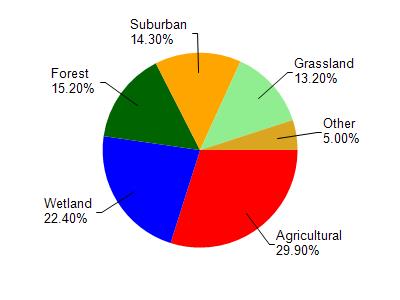Waukesha
No
No
No
Fish and Aquatic Life
Overview
Rock River Water Quality Management Plan, Lower Rock River Appendix. WT-668-2002. South Central Region, WDNR.
Upper Nemahbin Lake is a natural mesotrophic drainage lake on the Bark River. This lake also has a good warm water sports fishery and heavy recreational use. Water quality problems are due to nutrient and sediment loading from upstream; surrounding agricultural runoff; and urban runoff and erosion from construction sites. Septic systems in non-sewered areas may also be a water quality threat. The lake has good water clarity, though algae have been a problem in the past. Eurasian water milfoil, purple loosestrife and fluctuating water levels have also been problematic.
Date 2002
Author Aquatic Biologist
Historical Description
Source: 1963, Surface Water Resources of Waukesha County Upper Nemahbin Lake T7N, R17E, Sections 13 and 24
One of a chain of lakes bordering terminal moraine parallel to the interlobate moraine. The water is clear and much of the bottom is marl. The Bark River enters from Nagawicka Lake and exits unimpounded to Lower Nemahbin Lake. Pan fish, northern pike, largemouth bass and walleyes are common in the fishery. Carp are present but are not a use problem. The lake has at times had an algae problem. Swimming is prohibited at a public beach by order of the town board. Public access is afforded by a beach on the south end and by a launching site on the outlet channel. There are no adjoining wetlands of value to wildlife.
Surface Acres = 283, S.D.F. = 1.23, Maximum Depth = 61 feet
Date 1963
Author Surface Water Inventory Of Wisconsin
General Condition
Upper Nemahbin Lake (827100) was assessed during the 2016 listing cycle; total phosphorus and chlorophyll sample data were clearly below 2016 WisCALM listing thresholds for the Recreation use and Fish and Aquatic Life use. This water is meeting these designated uses and is not considered impaired.
Date 2015
Author Ashley Beranek
Condition
Wisconsin has over 84,000 miles of streams, 15,000 lakes and milllions of acres of wetlands. Assessing the condition of this vast amount of water is challenging. The state's water monitoring program uses a media-based, cross-program approach to analyze water condition. An updated monitoring strategy (2015-2020) is now available. Compliance with Clean Water Act fishable, swimmable standards are located in the Executive Summary of Water Condition in 2018. See also the 'monitoring and projects' tab.
Reports
Management Goals
Wisconsin's Water Quality Standards provide qualitative and quantitative goals for waters that are protective of Fishable, Swimmable conditions [Learn more]. Waters that do not meet water quality standards are considered impaired and restoration actions are planned and carried out until the water is once again fishable and swimmable
Management goals can include creation or implementation of a Total Maximum Daily Load analysis, a Nine Key Element Plan, or other restoration work, education and outreach and more. If specific recommendations exist for this water, they will be displayed below online.
Monitoring
Monitoring the condition of a river, stream, or lake includes gathering physical, chemical, biological, and habitat data. Comprehensive studies often gather all these parameters in great detail, while lighter assessment events will involve sampling physical, chemical and biological data such as macroinvertebrates. Aquatic macroinvertebrates and fish communities integrate watershed or catchment condition, providing great insight into overall ecosystem health. Chemical and habitat parameters tell researchers more about human induced problems including contaminated runoff, point source dischargers, or habitat issues that foster or limit the potential of aquatic communities to thrive in a given area. Wisconsin's Water Monitoring Strategy was recenty updated.
Grants and Management Projects
Monitoring Projects
| WBIC | Official Waterbody Name | Station ID | Station Name | Earliest Fieldwork Date | Latest Fieldwork Date | View Station | View Data |
|---|
| 827100 | Upper Nemahbin Lake | 683256 | Upper Nemahbin Lake - Deep Hole | 9/18/1980 | 8/26/2025 | Map | Data |
| 827100 | Upper Nemahbin Lake | 683453 | Upper Nemahbin Lake -- Boat Landing Next To I94 | 7/5/2004 | 5/30/2025 | Map | Data |
| 827100 | Upper Nemahbin Lake | 10007243 | Upper Nemahbin Lake | 7/3/1952 | 9/17/2019 | Map | Data |
| 827100 | Upper Nemahbin Lake | 684006 | Nemahbin Lake Upper - Nemahbin Lake Upper | 9/4/1979 | 9/4/1979 | Map | Data |
| 827100 | Upper Nemahbin Lake | 683366 | Upper Nemahbin Lake South Site - Near Delafield WI | 4/26/1994 | 6/11/2024 | Map | Data |
| 827100 | Upper Nemahbin Lake | 683135 | Upper Nemahbin Lake - Deep Hole | 9/17/1973 | 9/25/2020 | Map | Data |
| 827100 | Upper Nemahbin Lake | 683365 | Bark River (Upper Nenahbin Lake Outlet) - Near Delafield WI | 6/21/1994 | 8/23/1995 | Map | Data |
|

Watershed Characteristics
Upper Nemahbin Lake is located in the Bark River watershed which is 185.84 mi². Land use in the watershed is primarily agricultural (29.90%), wetland (22.40%) and a mix of forest (15.20%) and other uses (32.50%). This watershed has 265.69 stream miles, 3,499.26 lake acres and 22,145.94 wetland acres.
Nonpoint Source Characteristics
This watershed is ranked Medium for runoff impacts on streams, High for runoff impacts on lakes and High for runoff impacts on groundwater and therefore has an overall rank of High. This value can be used in ranking the watershed or individual waterbodies for grant funding under state and county programs.However, all waters are affected by diffuse pollutant sources regardless of initial water quality. Applications for specific runoff projects under state or county grant programs may be pursued. For more information, go to surface water program grants.